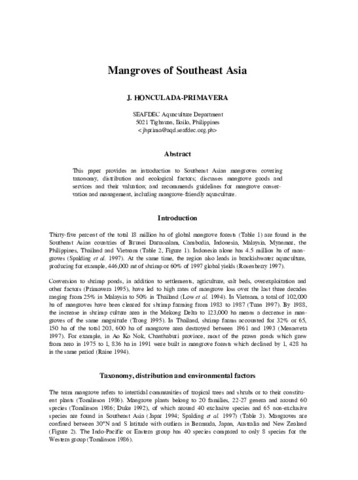Biodiversity in mangrove-derived aquaculture ponds in Dumangas, Iloilo, Philippines
| dc.contributor.author | Bagarinao, Teodora | |
| dc.coverage.spatial | Iloilo | en |
| dc.date.accessioned | 2021-04-06T02:16:34Z | |
| dc.date.available | 2021-04-06T02:16:34Z | |
| dc.date.issued | 2021-02 | |
| dc.identifier.citation | Bagarinao, T. U. (2021). Biodiversity in mangrove-derived aquaculture ponds in Dumangas, Iloilo, Philippines. Philippine Journal of Science, 150(1), 153-169. | en |
| dc.identifier.issn | 0031-7683 | |
| dc.identifier.uri | http://hdl.handle.net/10862/6042 | |
| dc.description.abstract | Large tracts of mangroves have been converted into aquaculture ponds and the consequent loss of biodiversity has been much decried. This paper shows that high aquatic biodiversity is retained in mangrove-derived aquaculture ponds in Dumangas, Iloilo, Philippines. Documentation of biodiversity was carried out over two years in 15 adjacent ponds (water areas 0.25–0.9 ha) used for farming penaeid shrimps, mud crabs, milkfish, seabass, rabbitfish, and other fishes. At harvest, these ponds yielded many extraneous non-crop or “bycatch” species, which had been naturally seeded by the tides and had grown (and some species reproduced) over the 2–10 mo that the ponds were underwater. From 21 crop cycles were obtained 8–56 species (from 6–30 taxonomic families) of bycatch fishes and macrocrustaceans with biomass of 2.5–168.4 kg ha–1 and abundance of 2–92 x 103 individuals ha–1, the differences due to pond area, duration of immersion, farming system, crop species, and the bycatch community. Some 85 species (44 families) of fishes occurred in the ponds, including 12 species of gobies, of which the small-size Acentrogobius viganensis, Pseudogobius javanicus, Mugilogobius cavifrons, and Gobiopterus panayensis reached high abundance. Macrocrustaceans consisted of 30 species (nine families), including several penaeid and palaemonid shrimps (Metapenaeus ensis and Nematopalaemon tenuipes were most common) and portunid and grapsid crabs. Mollusks in the ponds included 58 species (24 families), of which Cerithideopsilla cingulata was most abundant. The Dumangas ponds were leaky and allowed tidal recruitment of many mangrove animals despite net screens and chemical treatments. Existing tidal ponds serve as proxy mangrove lagoons (wetlands) that can harbor high aquatic biodiversity. | en |
| dc.description.sponsorship | The SEAFDEC Aquaculture Department funded this study. | en |
| dc.language.iso | en | en |
| dc.publisher | Science and Technology Information Institute, Department of Science and Technology | en |
| dc.relation.uri | https://philjournalsci.dost.gov.ph/images/pdf/pjs_pdf/vol150no1/biodiversity_in_mangrove-derived_aquaculture_ponds_in_Dumangas_Iloilo_.pdf | en |
| dc.title | Biodiversity in mangrove-derived aquaculture ponds in Dumangas, Iloilo, Philippines | en |
| dc.type | Article | en |
| dc.citation.volume | 150 | |
| dc.citation.issue | 1 | |
| dc.citation.spage | 153 | |
| dc.citation.epage | 169 | |
| dc.citation.journalTitle | Philippine Journal of Science | en |
| dc.subject.asfa | biodiversity | en |
| dc.subject.asfa | bycatch | en |
| dc.subject.asfa | mangroves | en |
| dc.subject.asfa | aquaculture | en |
| dc.subject.asfa | ponds | en |
| dc.subject.asfa | shrimp culture | en |
| dc.subject.asfa | milkfish culture | en |
| dc.subject.asfa | fish culture | en |
| dc.subject.asfa | composition | en |
| dc.subject.asfa | crab culture | en |
| dc.subject.asfa | sea bass culture | en |
| dc.subject.asfa | fauna | en |
| dc.subject.scientificName | Acentrogobius viganensis | en |
| dc.subject.scientificName | Pseudogobius javanicus | en |
| dc.subject.scientificName | Mugilogobius cavifrons | en |
| dc.subject.scientificName | Gobiopterus panayensis | en |
| dc.subject.scientificName | Metapenaeus ensis | en |
| dc.subject.scientificName | Nematopalaemon tenuipes | en |
| dc.subject.scientificName | Cerithideopsilla cingulata | en |
| local.subject | biodiversity | en |
| local.subject | bycatch | en |
| local.subject | Chanos | en |
| local.subject | gobies | en |
| local.subject | mangroves | en |
| local.subject | Penaeus | en |
このアイテムのファイル
| ファイル | サイズ | フォーマット | 閲覧 |
|---|---|---|---|
|
このアイテムに関連するファイルは存在しません。 |
|||
このアイテムは次のコレクションに所属しています
-
Journal Articles [1258]
These papers were contributed by Department staff to various national and international journals.




